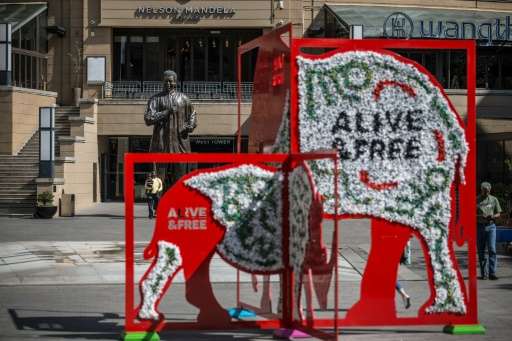The 'big five' decisions at wildlife trade meeting

The world's largest wildlife meeting wrapped up late Tuesday with conservationists hailing progress in tightening rules on trafficking of endangered species including sharks, grey parrots and pangolins.
But the Convention on International Trade in Endangered Species (CITES) conference in Johannesburg also exposed sharp differences over how to best protect Africa's elephants and rhinos.
Ten days of talks ended a day earlier than expected, with CITES chief John Scanlon describing the meeting as "a game changer for the planet's most vulnerable wild animals and plants".
More than 2,500 delegates sifted through 62 proposals to reform trade restrictions on more than 400 species. In all, 51 proposals were accepted, five rejected and six were withdrawn.
Wildlife campaigners generally welcomed the outcome, adding that concrete action was now needed to tackle a global boom in poaching and trafficking.
The World Wildlife Fund (WWF) said that governments had united behind "tough decisions", while the International Fund for Animal Welfare (IFAW) said that "conservation trumped commerce".
Among the animals affected by CITES decisions were:
African grey parrots
Governments overwhelmingly voted to outlaw all trade of the much sought-after African grey parrot.
The birds are prized as pets because of their intelligence and ability to mimic human speech. Their numbers have been hit by poaching as well as destruction of forest habitats.
The birds are now rarely sighted or locally extinct in countries including Benin, Burundi, Kenya, Rwanda, Tanzania and Togo.
African elephants
A high-profile bid by 29 African countries to have all African elephants included in the highest category of CITES protection was rejected after heated debate.
Namibia, South Africa and Zimbabwe—which boast healthy elephant populations—argued against the proposal, and southern African elephants stayed on the list that could allow for trade under stringent conditions.

The decision also split conservation groups, as arguments raged through the conference venue.
International trade in ivory remains banned, and campaigners urged governments to concentrate on tackling trafficking and ending ivory demand in Vietnam and China.
A new study revealed that the number of African elephants has fallen by around 111,000 in the past decade—the worst drop in 25 years.
Pangolins
Trade in all eight species of pangolin in Africa and Asia was banned when they were placed in CITES' top protection category to save them from extinction.
The shy, scale-covered pangolin has become the world's most heavily trafficked mammal, valued as an edible delicacy and ingredient in traditional medicine, especially in east Asia as well as across Africa.
They curl up into a ball when under attack—an effective tactic against lions, but one that allows human hunters to easily pick them up.
Rhino
A controversial bid by the tiny African kingdom of Swaziland to be permitted to trade its rhino horn was soundly defeated.
Some campaigners argue that providing a legal supply of farmed rhino horn is the only way to break a sudden boom in poaching that threatens the animal's survival.
Demand for rhino horn, which is composed of keratin—the same substance found in human nails—has soared in Vietnam and China, where it is believed to have medicinal powers capable of curing everything from hangovers to cancer.
Sharks
Thirteen species of devil rays, thresher sharks and the silky shark, populations of which have been in free-fall, won tougher protection when they were elevated into Appendix II of CITES, meaning they can be traded only under strict conditions.
A 2013 study estimated that 100 million sharks are killed every year —- twice the rate that conservationists say is sustainable.
Sharks are hunted for their meat, skin, liver oil and cartilage, with shark fin soup often consumed at prestigious banquets in China, Hong Kong and Singapore.
© 2016 AFP


















